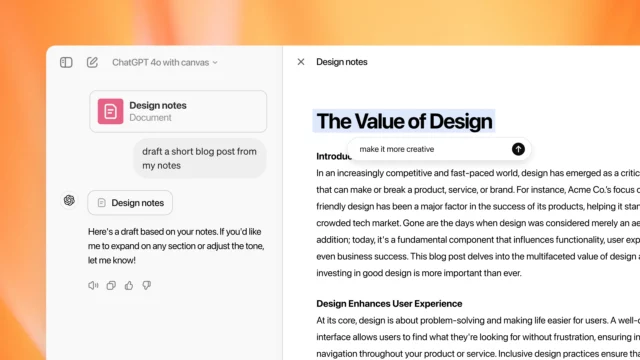OpenAI introduces Canvas: A new way to collaborate with ChatGPT for writing and coding

OpenAI has introduced a new interface called “Canvas,” designed to enhance collaboration with ChatGPT for writing and coding projects. Unlike the standard chat interface, Canvas allows users to interact with their projects more dynamically by opening in a separate window where users and ChatGPT can work side by side. This feature, currently in beta, is available for ChatGPT Plus and Team users, with plans to extend access to Enterprise and Edu users soon. Once the beta phase is complete, the feature will eventually be made available to ChatGPT Free users.
Canvas uses GPT-4o and can be manually selected in the model picker. The aim is to offer a better interface for tasks requiring multiple revisions and edits, such as writing content or coding. The chat interface works well for many tasks, but canvas is designed to address the needs of users working on more complex projects that benefit from a more structured environment.
In Canvas, users can work on their projects with greater control, including editing text or code directly, getting suggestions, and managing versions of their work. For writing projects, canvas allows users to highlight specific sections, giving ChatGPT the ability to offer more targeted feedback. It provides suggestions for editing, length adjustments, and checks for clarity and consistency. Users can also tailor the reading level of their writing or add finishing touches like checking for grammar.
For coding tasks, Canvas is designed to make it easier to track revisions and get inline feedback. ChatGPT can review code, add debugging tools, insert comments, fix bugs, and translate code into different languages. These tools make Canvas more suitable for iterative work, which often involves multiple rounds of revisions.
The development of Canvas involved extensive training of GPT-4o to make it act as a collaborative partner. It can determine when canvas should be triggered for certain tasks, such as writing a blog post, while avoiding unnecessary use for simpler tasks like answering general questions. The model’s ability to correctly trigger canvas for both writing and coding tasks has improved to 83 percent and 94 percent respectively, compared to a baseline model.
The team also focused on training the model to decide between making targeted edits or rewriting content entirely, based on user input. If users select specific text, ChatGPT will make targeted edits; otherwise, it may opt for a full rewrite. Improvements have also been made to the way canvas generates comments in coding projects, with human evaluations showing that it outperforms baseline models by 30 percent in accuracy and 16 percent in quality.
